
An Ecstatic Solo Backpacker
Are you fond of exploring ancient architectural ruins? And what about doing it by yourself?
I've always wanted to be a solo backpacker so, as a way of escaping my comfort zone, traveling alone to different international destinations was the ultimate test! This was my practical measure of trying out my personal courage and perseverance, plus quenching my curiosity for discovering exotic landmarks. I could still vividly remember not being able to contain my restless excitement days before this trip!

In the third episode of Architecture Moments™, I'll be taking you to one such exotic landmark in Cambodia that many travelers, explorers, and architectural enthusiasts dream of experiencing. In this country, Siem Reap is the second-largest city and is the gateway to the ancient ruins of Angkor, the majestic hub of the Khmer Empire from the 9th to the 15th centuries AD. There are a plethora of ancient temple ruins sprawling across this bustling metropolis however, for this publication, we'll focus on the most celebrated of them all: Angkor Wat.
Convenient Way Around
Unless you have already booked a private vehicle to tour you within Siem Reap, there are other convenient modes of public transportation available for hire. Another advantage is that there are road signs everywhere so you won't get lost.

During my week-stay there, my favorite ride was the Tuk Tuk, a 2-wheeled carriage pulled by a motorbike that can accommodate 2 people to a small group of passengers. These distinctive vehicles are a common sight in Cambodia, and most especially in Siem Reap where tourists abound simply because of the popular temple ruins.


While cruising around the city with the Tuk Tuk, I freely enjoyed the architectural sights of both the old remnants and new additions to the urban landscape and kept clicking away with my camera while on the go. And on my way to Angkor Wat, that was what I did. It was an absolutely fun escapade!
Grand Portal to Another World
I knew that it was already near Angkor Wat since the large artificial moats were visible. These were relatively massive bodies of water that were 650 feet wide (200 meters), totaled an overall perimeter of 3 miles (5 kilometers), and had a depth of 13 feet (4 meters), surrounding the temple complex.


While passing along the moat, a strong breeze blew and seemed to have welcomed me to a different time and place. Several hundred years ago, this massive kingdom would have appeared differently without the lush vegetation and the thick forest that has already engulfed it today.


To have an idea of how massive the surroundings are, have a look at the aerial view and floor plan of Angkor Wat.


A few moments later, my personal tour guide (Tuk Tuk driver) and I arrived at the west gate. And there, visitors would be greeted by signage explaining the current conservation efforts for the temple.

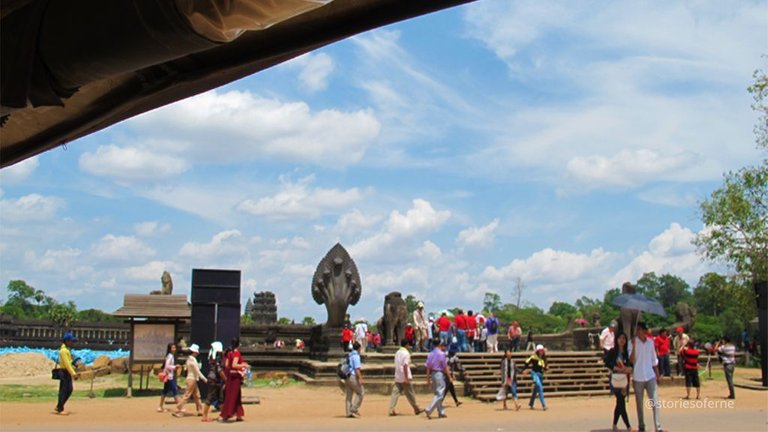
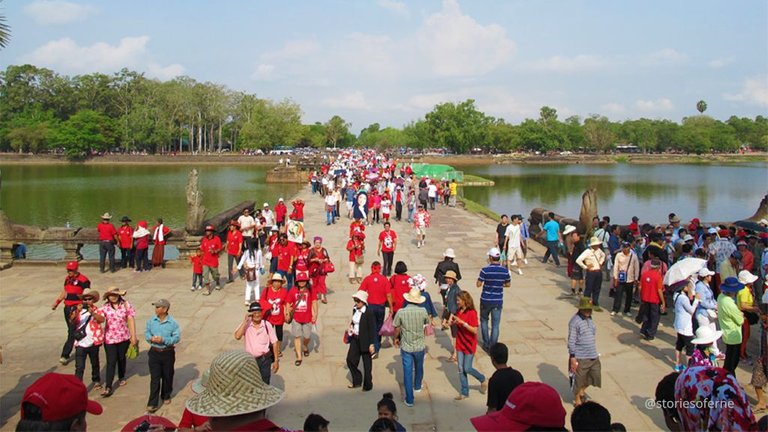
In that same location was also the land bridge or stone causeway that led to the main attraction. As this was a popular destination, there were many people that crowded the area. I was glad the weather was sunny that day and was the suitable atmosphere to explore interesting ruins like these.
A Delicious Taste of Khmer Architecture
Being the largest religious monument in the world in terms of land area, Angkor Wat is the titleholder! The entire temple complex was made out of sandstone blocks that were extracted from the mountain of Phnom Kulen, around 50 kilometers away, and then transported on floating rafts along the Siem Reap River. Aside from sandstone, a type of local clay called laterite, was used to clad the outer walls and hidden structural components. It's also said that natural resin or slaked lime was the primary binding element for these sandstone blocks. Believe it or not, it took a staggering 300,000 laborers and 6,000 elephants to complete this gigantic building project!
As I passed beyond the Elephant Gate and stepped into the inner perimeter of the temple complex, my eyes immediately became busy gazing at this huge masterpiece of religious symbolism. I spent some time there as I can only marvel at the wonderful sights of what is considered the most exquisite example of the classical style of Khmer architecture that lay in front of me.

Khmer architecture reached its prime during the reign of King Suryavarman II who initiated the construction of Angkor Wat when he ascended to the throne in 1113. This religious monument was originally built as a Hindu temple for the god Vishnu but, by the culmination of the 12th century, it was converted into a Buddhist place of worship by King Jayavarman VII. For the former king, this temple also served as a funerary site, burial grounds for his mortal remains, and as a tribute for his eternal life.

I was mesmerized by the different details that made this architectural style distinct. Some of the most prominent ones were the Ogival (lotus bud-shaped spires), half and axial galleries, cruciform terraces, connecting enclosed spaces, and far-stretching hallways containing vast arrays of several religious narratives and symbolic details.



What caught my undivided attention was the beautiful Apsara carved and sculpted as bas reliefs on the majority of the various walls, columns, lintels, friezes, pediments, surfaces, and roofs around the temple complex. These were supernatural female beings found on the clouds or water as depicted in Hindu or Buddhist culture. These female spiritual entities have been known for their elegance, youthfulness, and their skillful flair in the art of dancing.

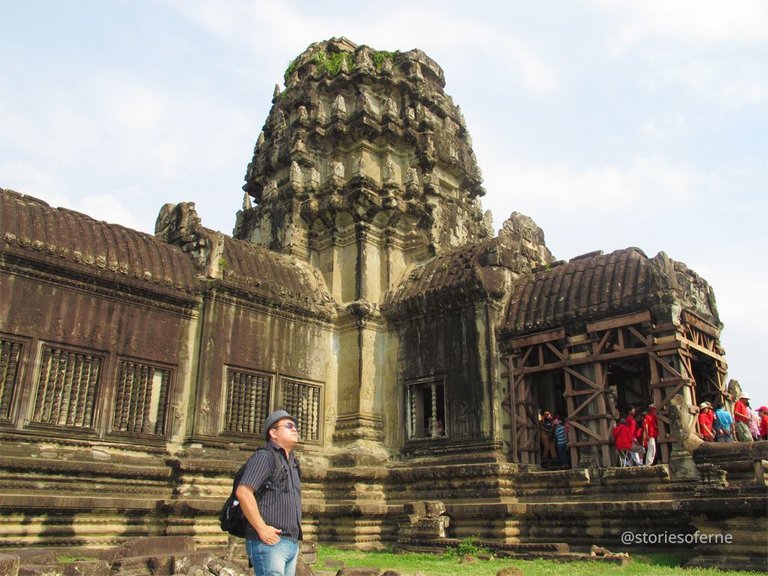
Other remarkable structures and buildings on the outside perimeter of the main religious shrine were the concentric rings of rectangular colonnaded galleries and terraces that were part of the typical architecture of the monument. A couple of related buildings called libraries were detached from the central shrine right before you enter the inner enclosure.



Conservation activities were also ongoing for these libraries located inside the outermost enclosure of the temple complex, one on the north side and the other on the south side as the signage has described. I also took the time to explore their interior spaces and they too, have similar characteristics to the usual Khmer architectural style used all around the area.


These 2 libraries were identical to each other and were said to be storage places or repositories of religious documents, manuscripts, and related texts.
Respectful Entry to the Inner Sanctum
From there, I walked slowly to the central walkway that led to the inner grounds or interior enclosure of the main religious monument of Angkor Wat. But before that, I took a stunning photographic capture of this famous shot of the temple as what's shown in most media channels.

Also known as the Bakan, the inner enclosure of the main temple is a special area containing axial galleries linking each Gopura with the central religious shrine situated below the main corner towers.





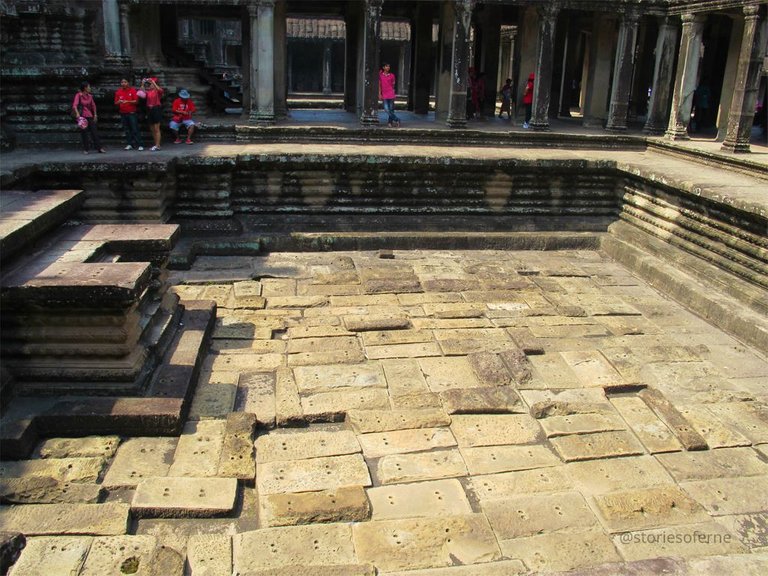


With reverence to the sacred surroundings, I walked in silence while examining all the amazing architectural details that were plenty in the area. This was my way of offering respect to the holy ground I was standing on. There was also a small Buddhist altar where devotees can offer prayers.

At the same time, I also felt goosebumps due to the extremely old environment I was in.








From there I stepped out into the central open area where you can clearly see the iconic 5 towers of Angkor Wat at close proximity.




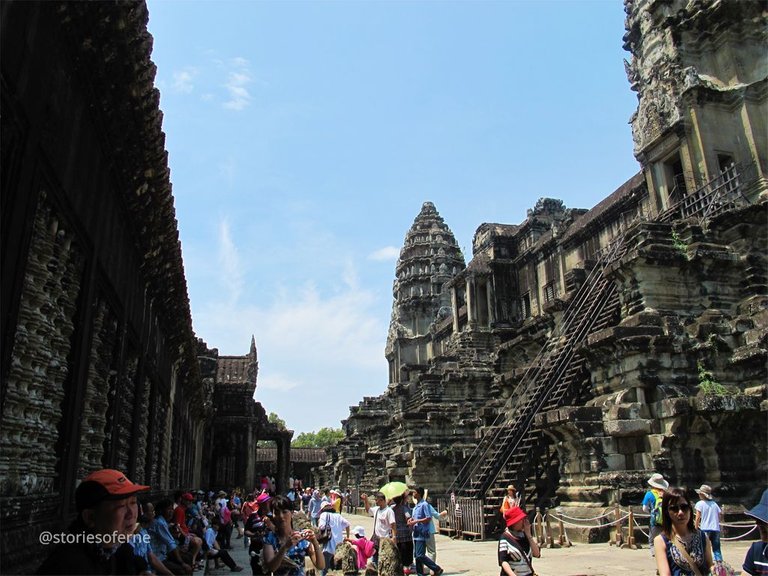
Khmer architecture was at its finest in this inner enclosure of the main religious shrine. I was having a sensual feast as I stayed there longer than usual to savor everything its space has to offer.
The Majestic Towers of Divine Glory
In the Hindu and Buddhist traditions, the 5 stone towers of Angkor Wat were designed to symbolize the 5 mountain ranges of Mount Meru, believed to be the mythical home of the gods.

The extremely inclined slope of the stairways leading to the towers above was to represent the difficult journey of ascending towards the divine kingdom of the gods.


While enjoying myself there with the magnificent surroundings, I didn't miss the chance to have a picture with a Buddhist monk who happened to pass by the area.

As a tradition of Khmer architectural design, Southeast Asian Architects conceived the concept of the temple mountain to serve Hindu gods as depicted by Mount Meru. The empty spaces, courtyards, galleries, moats were all there to symbolize the mountains, landscapes, and oceans that surround this heavenly home of the gods.


The most recognizable architectural feature of Angkor Wat is the Ogival. These are the distinctive towers shaped like a lotus bud. At a close distance, these exquisite sandstone carvings show the fine craftsmanship of builders who had limited tools during their time. It was an awesome sight!


The central pyramid of the main religious shrine takes the shape of 3 stepped terraces with roofed galleries and enclosures covering the entire perimeter of each step. The massive towers were what defined each corner as shown on the second and third steps.
Magnificent Outer Courtyards
Known also as the outer enclosure of the temple complex, these open spaces can be accessed from the different galleries surrounding the perimeter. At least these areas were also well maintained and preserved to show the original grandeur of this religious monument.
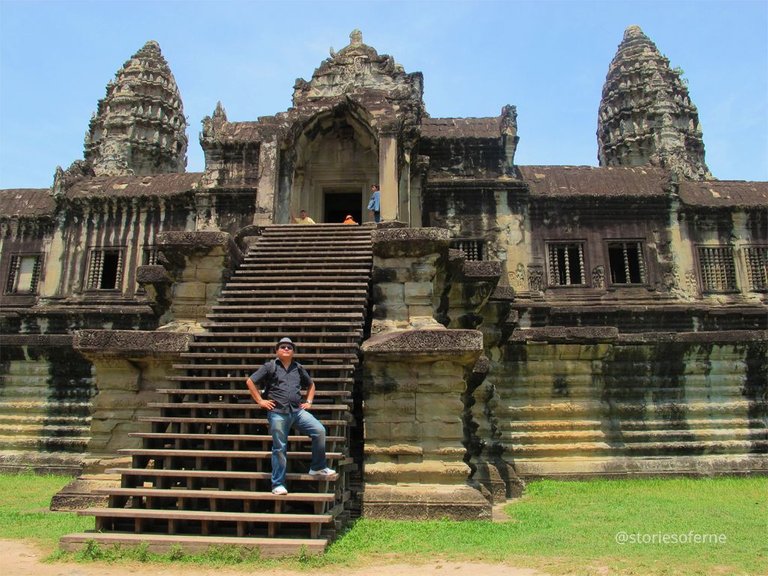





Other libraries can also be seen on this part of the religious monument. And they more or less identical to the ones found on the west side of the outer enclosure.
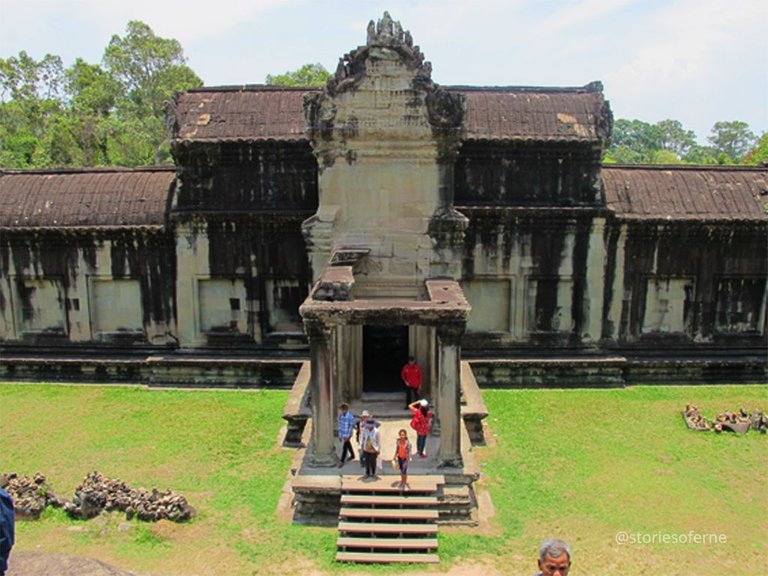


As far as my eyes could see, the forests have already eaten away the exterior proximities of the main shrine. There were lots of trees, shrubs, and other plant life that continued to exist with the deteriorating structures.
Valuable Lessons Learned
I consider ancient ruins and architectural heritage sites as "live classrooms". Why? Aside from just being clear evidence of the exemplary work these buildings exhibit, they serve as time machines that transport us back to a period to show how life could have been. In their various details, we could find significant clues, hints, and stories that are vital to our evolution as a human species.

Because Angkor Wat was such a strategically historic part of the development of Cambodia, it was declared a UNESCO World Heritage Site in 1992. Until today, conservation works are ongoing to maintain this iconic landmark that deserves to be experienced for many generations to come.

#Hive, what are your thoughts about the architectural heritage of Angkor Wat?
 Subscribe to the Architecture+Design Community, an Active Member of the OCD Communities Incubation Program, and refer to our Welcome Message & Comprehensive Guidelines for more details.
Subscribe to the Architecture+Design Community, an Active Member of the OCD Communities Incubation Program, and refer to our Welcome Message & Comprehensive Guidelines for more details.



Wow wery good job ;))
Thank you so much @denisdenis!
Congratulations for your publication @storiesoferne. I have heard that when you go to Angkor temples, you can't miss to see the sunrise from the main temple. Thank you for showing us this great historical construction.
Yes, that's true @darwinperez! The spectacular sunrise can be experienced from the temple ruins of Angkor Wat. Thank you for your interest and for stopping by!
How beautiful the building is, of course, has a high historical value.
Wow amazing ....
One of the wonders of the world where this building is very neat, it is fitting for the people around the building to look after and care for it properly.
This building is a world asset, which will be inherited to their children and grandchildren.
In Indonesia there is also one very ancient building, which is one of the wonders of the world, namely the Borobudur temple.
My eyes don't blink when I see Angkor Wat architectural buildings?
Allow me to reblog , sir.
Thank you @ipolatjeh1988 for your appreciation! Angkor Wat is certainly a piece of architectural history to behold and must be continuously preserved for its long-term survival.
I really agree with your words, the legacy of the ancestors must be preserved and preserved for the future to come ..
I also can't wait to show you the historical architectural buildings in my area.
This is something, unique and astounding example of historical architecture. Oh details, they are incredible. I have seen this type of structural details in my country but not huge, moreover, they are temples and pagodas... But this one is something...
Certainly @priyanarc, Khmer architecture is a unique design style in its own right! And the amount of fine details involved in the final output of this magnificent religious building is unprecedented and incomparable. You have to be there in person to be awed at the beauty of this masterpiece. Thank you for your beautiful remark!
Wow! Thank you for taking us to this iconic place through your photos Erne, I would love to visit one day... That´s a massive load of great shots! Awesome collection.
Much appreciated @phortun! Angkor Wat is definitely a one-of-a-kind experience and must be on every traveler's bucket list. You would surely love it there as this exotic landmark has lots of photographic opportunities.
Such Magnificent buildings and structures.
Angkor Wat? I haven't about such before, you sure had a great tour in one of the landmark of Cambodia.
I wonder how long this building would last
It was indeed an enjoyable tour of Angkor Wat @zellypearl! As this is a world-renowned landmark, I'm truly glad I had the chance to experience it in my lifetime. I encourage you to travel there while it's still present.
That place seems mystical. Exploring Angkor Wat seems like a wonderful experience. At first glance I thought it is a Hindu temple in India but later realised it's in Cambodia. what a masterpiece it is and rooted Buddhist and Hindu influences could be observed vividly. I agree, that they are like virtual time travel. By the way what else excited you in that country as solo trips are totally a different experience.
Keep traveling and flourishing @storiesoferne!
Angkor Wat is indeed a mystical place, and there are many obvious details, signs, and depictions to support it! I've also read an interesting article saying this temple complex has some Indian influence due to the similarities of religious cultures. I'm glad you enjoyed this architectural tour and thank you @praditya for taking the time to digest my post!
Indeed it was an interesting one to go through!
Congratulations @storiesoferne! You have completed the following achievement on the Hive blockchain and have been rewarded with new badge(s) :
Your next target is to reach 3000 upvotes.
You can view your badges on your board and compare yourself to others in the Ranking
If you no longer want to receive notifications, reply to this comment with the word
STOPCheck out the last post from @hivebuzz:
Thank you @hivebuzz, keep shining!
You're welcome @storiesoferne 😊 Nice motivation!
Hi Erne, the first time I came across Angkor Wat was when we were asked to draw it during History of Architecture classes in college. Since then I was intrigued by it. I do agree with "live classrooms." There's a big gap between experiencing it as opposed to just reading it from a history book. It's funny how I just mentioned to you, I was thinking about Angkor Wat this week and you shared your experience here. We are indeed on the same wavelength.
Yes Arni, Angkor Wat is one of the architectural community's most sought-after heritage buildings to study, admire, and explore! It's great to view them in books but, nothing beats the actual experience of its majestic splendor. And definitely, magic happens when our beautiful thoughts become one! haha.
Indeed, wishing you a splendid holy week!
Hello friend Erne, I greet you from Venezuela with respect and much affection. OMG! The majesty of Angkor Wat left me speechless. The truth is, I congratulate you on the quality of your publication. Thank you for taking us for a ride to that beautiful and historic place. God bless you always friend.
Hello Marcos, my friend. Angkor Wat is a truly marvelous wonder of architecture! It also made me speechless the first time I saw it because I was amazed at the amount of construction and artistic skill used in the creation of this historic religious masterpiece! More blessings and stay safe always!
Personally, these two photos seemed the best to me. One because I consider that there is nothing better than sitting on the edge of a wall to contemplate the landscape and the other because I find it interesting that there is a perfect hole to hide a scroll inside the statue.
congratulations on your post, it becomes addictive to see the photos looking for new details :D
Thank you @randomproject123 for your interesting comment! First, it was a windy but sunny day during my visit to Angkor Wat so, people find it relaxing to enjoy the soothing breeze and the surroundings while taking a break. Second, the hole on the statue is indeed a clever contraption to hide a piece of scroll. I never thought of it that way. Cheers!
an interesting place, you can see ancient buildings that are still intact and become a place for world tourists
It certainly is an architectural treasure! Thank you @fajarsdq for visiting!
The mesmerising architecture is breath-taking. Taking local transport in any place one visit is the most interesting thing, also that temple seems majestic, from those little sculptures to high ceiling hallways, everything describes how our ancestors respected the architecture and they knew how to create beautiful places which lasted years long. Those pictures are wonderful.
Understanding level turn different when we visit places instead of bookish knowledge. Did you hired a guide there? as it is always knowledgeable to do so.
It is indeed a magnificent place @sahiba-rana! Your actual presence in that location is important to truly savor the various details in their beautiful presentations. My personal tour guide was my Tuk Tuk driver who also happened to be a Cambodian native and was very knowledgeable about Angkor Wat and the surrounding temple ruins. I was fortunate to have found him as he was a friendly and accommodating person. As an Architect yourself, I invite you to travel and explore Angkor Wat to be able to experience this once-in-a-lifetime religious architectural gem!
Oh I would surely visit Angkor Wat It seems a beautiful and learning experience to visit. Thanks for the virtual tour through your post.
Hiya, @ybanezkim26 here, just swinging by to let you know that this post made it into our Honorable Mentions in Daily Travel Digest #1159.
Your post has been manually curated by the @pinmapple team. If you like what we're doing, please drop by to check out all the rest of today's great posts and consider supporting other authors like yourself and us so we can keep the project going!
Become part of our travel community:
Many thanks, Kim for the mention!
This is Just Fascinating, when it comes to shrines, their structures are often out of this world.
I agree @badbitch! Religious monuments, buildings, and structures have been one of the world's most interesting works of historic architecture!
Wow excelentes paisajes y tambien las fotos, gracias por compartir.
This is appreciated, thanks so much @comandoyeya!
Congratulations, your post has been added to Pinmapple! 🎉🥳🍍
Did you know you have your own profile map?
And every post has their own map too!
Want to have your post on the map too?
Thank you for sharing this amazing post on HIVE!
Your content got selected by our fellow curator @priyanarc & you just received a little thank you via an upvote from our non-profit curation initiative!
You will be featured in one of our recurring curation compilations and on our pinterest boards! Both are aiming to offer you a stage to widen your audience within and outside of the DIY scene of hive.
Join the official DIYHub community on HIVE and show us more of your amazing work and feel free to connect with us and other DIYers via our discord server: https://discord.gg/mY5uCfQ !
If you want to support our goal to motivate other DIY/art/music/homesteading/... creators just delegate to us and earn 100% of your curation rewards!
Stay creative & hive on!
Thanks a lot, @diyhub and @priyanarc for the selection!